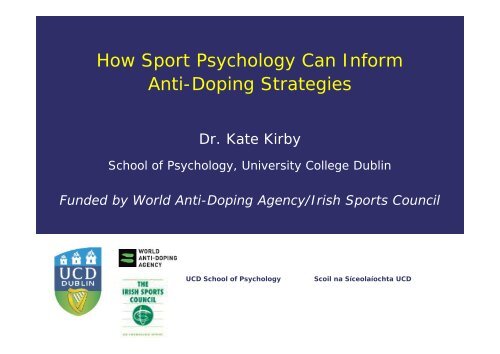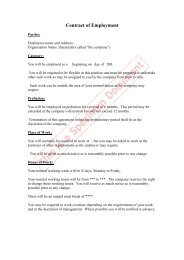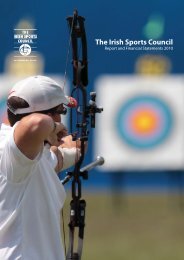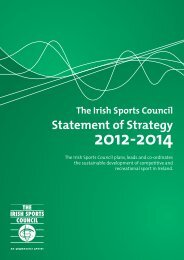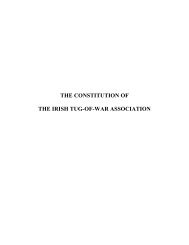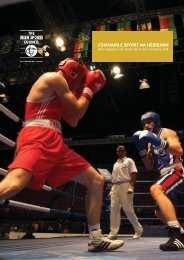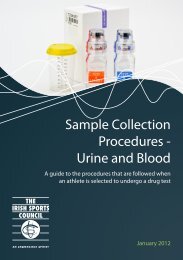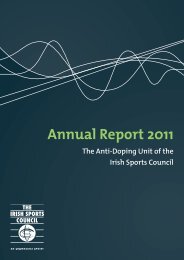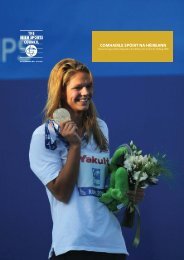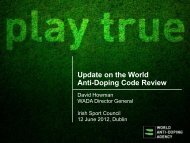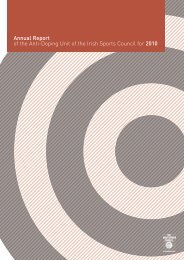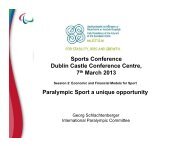Dr Kate Kirby School of Psychology UCD Presentation.pdf
Dr Kate Kirby School of Psychology UCD Presentation.pdf
Dr Kate Kirby School of Psychology UCD Presentation.pdf
Create successful ePaper yourself
Turn your PDF publications into a flip-book with our unique Google optimized e-Paper software.
How Sport <strong>Psychology</strong> Can Inform<br />
Anti-Doping Strategies<br />
<strong>Dr</strong>. <strong>Kate</strong> <strong>Kirby</strong><br />
<strong>School</strong> <strong>of</strong> <strong>Psychology</strong>, University College Dublin<br />
Funded by World Anti-Doping Agency/Irish Sports Council<br />
<strong>UCD</strong> <strong>School</strong> <strong>of</strong> <strong>Psychology</strong><br />
Scoil na Síceolaíochta <strong>UCD</strong>
Introduction<br />
• Doping in sport has attracted increased research<br />
interest from psychologists in recent years<br />
• Such research has tended to investigate correlates<br />
or predictors <strong>of</strong> athletes’ attitudes to doping and/or<br />
their intent to engage in doping<br />
• These studies have typically measured demographic,<br />
motivation & sportspersonship/moral variables
Linking doping research and<br />
practice<br />
• Doping controls have traditionally relied on<br />
detection-based methods to deter athletes from<br />
doping<br />
• Prevention-based methods have historically <strong>of</strong>fered<br />
little beyond the provision <strong>of</strong> information about<br />
avoiding testing positive and outlining the dangers<br />
& consequences <strong>of</strong> doping (Dimeo, 2011)<br />
• BUT...by identifying social & personality variables<br />
associated with permissive doping attitudes,<br />
intentions or behaviours we can:<br />
– (a) identify the factors that predict doping and thereby<br />
detect ‘at-risk’ athletes<br />
– (b) develop evidence-based doping prevention methods
Study 1<br />
What are the psycho-social predictors <strong>of</strong><br />
athletes’ attitudes to doping<br />
Variables measured<br />
• Demographic & sporting<br />
background, doping experience<br />
• Psychological variables<br />
including confidence,<br />
perfectionism, motivation,<br />
coaching climate<br />
• Correlated with Performance<br />
Enhancement Attitudes Scale<br />
Demographics<br />
• N = 375 (64% m; 36% f)<br />
• Mean age = 23.8 yrs<br />
• 16 countries, 27 sports<br />
• International: 46.3%<br />
National: 20.7%<br />
Regional: 33%<br />
• 49.3% hardcopy<br />
50.7% online
Significant predictors <strong>of</strong> athletes’ attitudes to<br />
doping, using multiple regression analysis<br />
Predictors B SE B β<br />
Ego orientation 0.27 .08 .16*<br />
Gender -3.33 1.01 -.17*<br />
Knowing dopers -3.11 0.98 -.16*<br />
Coach criticism 0.39 0.92 .22**<br />
Team sport -3.14 1.01 -.16*<br />
R 2 = .02. *p
What does this mean in practical terms<br />
• The combination <strong>of</strong><br />
variables that predicted<br />
the most permissive<br />
doping attitudes were:<br />
• High ego orientation<br />
• Male<br />
• Personally knowing other<br />
doping athletes<br />
• Having an overtly critical<br />
coach<br />
• Being a non-team sport<br />
athlete
Study 2: A qualitative investigation <strong>of</strong><br />
elite athletes’ doping experiences<br />
• Rationale<br />
– Dissatisfaction with proportion <strong>of</strong> variance explained<br />
in study 1 (80% still unexplained).<br />
– No study had attempted this before with competitive<br />
athletes, yet such information is vital to inform<br />
evidence-based doping prevention methods.<br />
• Aims<br />
– Explore in greater depth the individual, social and<br />
contextual factors that influenced athletes’ doping<br />
decisions
Study 2: Qualitative Research<br />
Research design:<br />
• Semi-structured interviews with<br />
athletes who admitted to doping<br />
for the purpose <strong>of</strong> illegally<br />
enhancing performance<br />
Participants:<br />
• N = 5 (All male; 2 Irish, 2 US;<br />
1 Scandinavian)<br />
• Age 29-45 years<br />
• All pro or Olympic level<br />
• 3 road cyclists<br />
• 1 mountain biker<br />
• 1 weightlifter
Summary <strong>of</strong> themes identified as<br />
significant in athletes’ doping decisions<br />
Factors influencing doping decision<br />
1. Internal factors 2. External factors 3. Doping deterrents<br />
a. Consideration and justification<br />
a. Pressure<br />
a. Internal factors<br />
b. <strong>Psychology</strong> and personality<br />
b. Ease <strong>of</strong> access<br />
b. External factors<br />
c. Personal circumstances<br />
c. Sources <strong>of</strong> influence within sport<br />
d. Sources <strong>of</strong> influence outside sport
Practical Implications <strong>of</strong> Findings – Part 1<br />
1. Morality and ethical concerns were the most<br />
prominent factors in athletes’ decision-making and<br />
acted as the strongest deterrent to doping<br />
“...their upbringing and their moral character and you know,<br />
what their value system is, that can be the crux <strong>of</strong> whether<br />
or not they decide to dope”<br />
– Anti-doping programmes should move beyond provision<br />
<strong>of</strong> information, to teaching <strong>of</strong> moral decision-making<br />
2. ‘Critical incidents’ that led to doping included:<br />
injury, time <strong>of</strong>f from sport, sudden drop in performance, new<br />
training environment & removal <strong>of</strong> coaching role model<br />
– Identifying these ‘doping tipping points’ in the careers <strong>of</strong><br />
elite athletes should inform the timing <strong>of</strong> preventative<br />
interventions
Practical Implications <strong>of</strong> Findings – Part 2<br />
3. In a team sport environment, the desire to<br />
remain part <strong>of</strong> the group was a strong incentive to<br />
dope<br />
“It’s this almost implied pressure to participate in the same<br />
kind <strong>of</strong> illegal and unethical activities as everyone else<br />
because if you don’t, it calls into question your eh, your<br />
ability to be trusted, I guess, by your team-mates.”<br />
– Pressure from teammates to dope was not direct, but<br />
implied<br />
– Teaching athletes how to withstand such forms <strong>of</strong><br />
pressure is likely to be an effective preventative measure<br />
– When the athletes were caught doping, these team<br />
‘bonds’ quickly disappeared
Practical Implications <strong>of</strong> Findings – Part 3<br />
4. Potential health consequences <strong>of</strong> doping were not<br />
serious concerns for athletes in their initial decision<br />
to engage in doping<br />
“The health consequences I didn’t worry about at all”<br />
– Threat-based deterrence methods are less effective than<br />
ones which emphasise development <strong>of</strong> self-control &<br />
willpower to resist the temptation to cheat<br />
5. Athletes <strong>of</strong>ten did not consider the likelihood <strong>of</strong><br />
testing positive when deciding to dope<br />
“I told myself, you’re not going to get caught anyway so why<br />
bother worrying about it”<br />
– On its own, the detection-based system <strong>of</strong> drug testing &<br />
sanctioning is an ineffective deterrent for some athletes<br />
– Preventative measures which go beyond provision <strong>of</strong><br />
information and are based in social science research also<br />
have an important role to play in the fight against doping.
Future research directions<br />
• Research with high performance coaches on knowledge,<br />
attitudes and intentions with respect to promoting anti-doping<br />
• Data will be collected through online questionnaire.<br />
• If you have access to a database <strong>of</strong> coaches, your help with<br />
distributing the questionnaire would be much appreciated!<br />
For more information please contact<br />
kate.kirby@ucd.ie<br />
Research Team: <strong>Dr</strong>. <strong>Kate</strong> <strong>Kirby</strong>, Pr<strong>of</strong>. Aidan Moran, <strong>Dr</strong>. Suzanne<br />
Guerin


